Let’s face it, gardening can be a chore sometimes. You have to plant, replant, dig up, store, plant again, and maintain the garden. While it’s a hobby many of us enjoy, it can be quite taxing. Why not make life a little easier by planting some foliage that will do some of the work for you?
That’s where perennials come in. Thanks to their ability to come back year after year, perennials can save you a lot of time and planting. Not all perennials are created equally, however, and you have to be careful of bringing a plant that can’t survive the climate of your garden.
Zone 5 perennials are a special lot. They need to be able to handle the heat without suffering from cold spells. So, without further ado, here are 37 wonderful zone 5 perennials to fill your garden with.
Allium
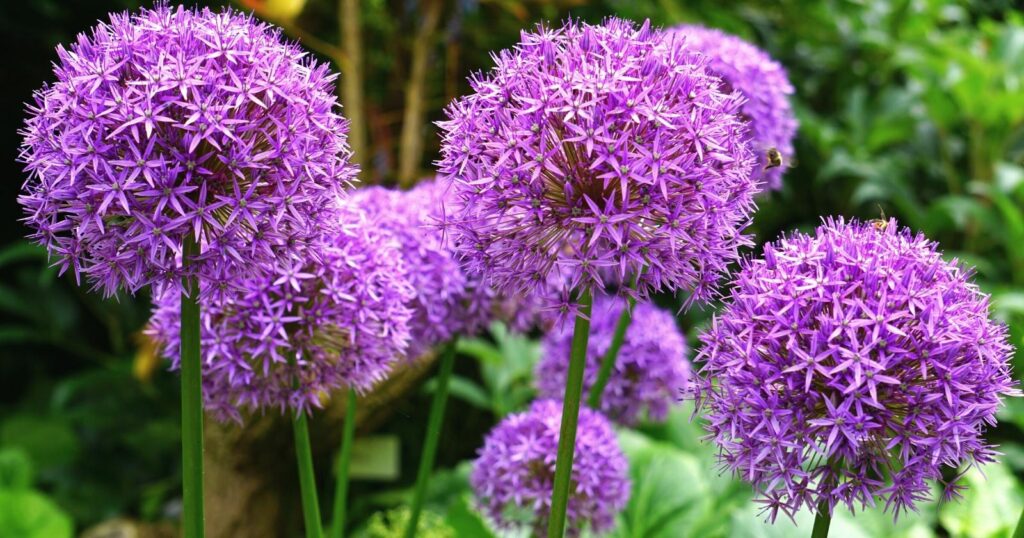
Scientific Name: Allium
- Sun Exposure: Full sun, Partial sun
- Height When Mature: 18-24″ tall
- Soil pH: 5.5 to 6.5
- Plant Zone: 3 to 9
Allium comes from bulbs and belongs to the same family as onions and garlic. It is a fairly sizable plant as it can grow to be over four feet tall and make large globe-like flowers that measure six to eight inches across.
Allium plants love sunlight and thrive in the summer heat. They grow in almost any type of soil including chalky, sandy, and clay. They are also resistant to drought and unbothered by deer and rabbits. Butterflies adore allium.
For the best aesthetic results, plant allium bulbs in clusters of ten to fifteen. Plant them in the fall.
As with most drought-resistant plants, allium likes well-drained soil and doesn’t need excessive watering. Because of its cold tolerance, Allium is a popular perennial down to hardiness zone 3.
Aster
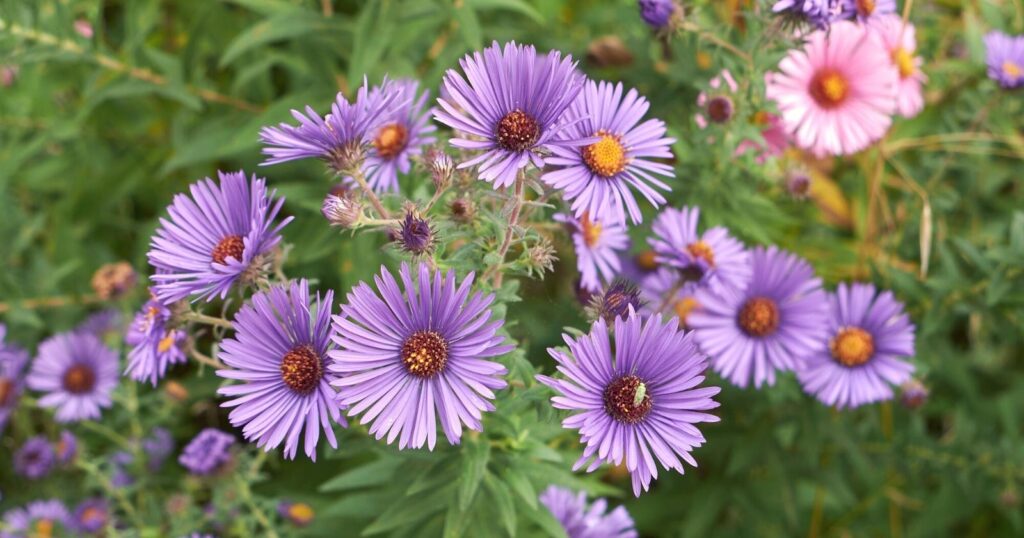
Scientific Name: Aster
- Sun Exposure: Full sun
- Height When Mature: 1-6′ tall, 1-4′ wide
- Soil pH: 5.8 to 6.5
- Plant Zone: 3 to 8
Aster is native to North America, Europe, and temperate Asia. It grows in well-drained chalk, loam, and sand soils. Aster is a relatively small plant, standing at six to twelve inches high with a spread of fifteen to thirty.
Aster enjoys direct sunlight and doesn’t need very much water or attention. Though it can have issues with slugs, snails, eelworms, aphids, leaf spots, wilt, or gray mold, it’s rare.
Aster blooms in the late spring and flowers until mid-summer. Butterflies love it, and it is resistant to droughts, deer, and rocky landscapes.
Aster makes thin perennial purple petals around a bright yellow center, adding contrast to any garden.
Astilbe
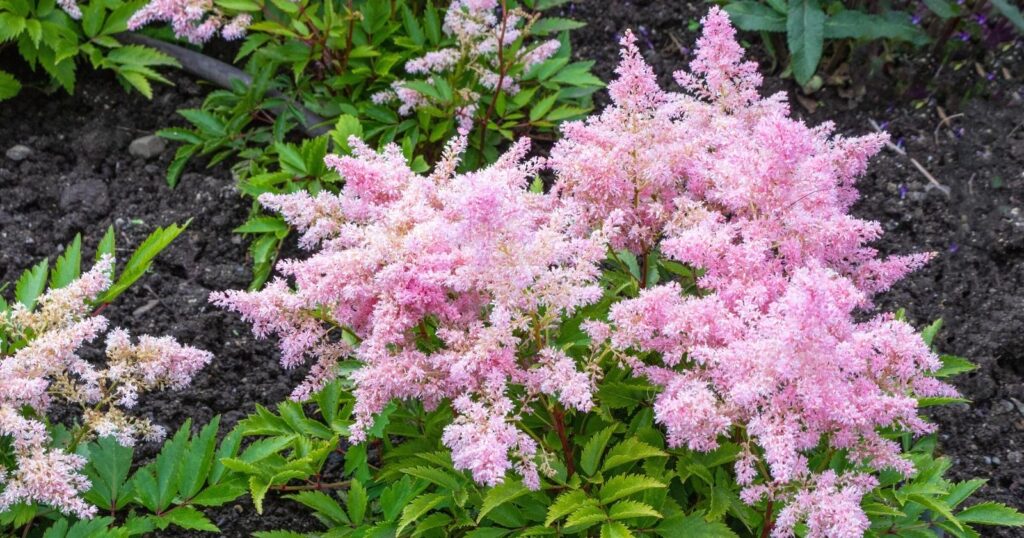
Scientific Name: Astilbe
- Sun Exposure: Partial shade
- Height When Mature: 1-4′ tall
- Soil pH: 5.5 to 7.0
- Plant Zone: 3 to 9
Astilbe flowers are gorgeous and fluffy with talk petal-covered stalks. They bloom mostly in June and August. Astilbe comes in many color variations, all bright and beautiful.
Astilbe loves to get lots of sunlight but can benefit from partial shade too. It can grow anywhere from six to twenty-four inches high and spreads out six inches to five feet wide. Astilbe has rhizomatous roots and can send shoots up anywhere along the length of them.
This plant is a fabulous addition to any garden and can withstand deer, rabbits, and excessively wet soil. It likes lots of water but needs good drainage too. Astilbe usually prefers loam soil.
Astilbe has dense green foliage most of the year and the flowers turn a rich caramel in winter.
Barrenwort
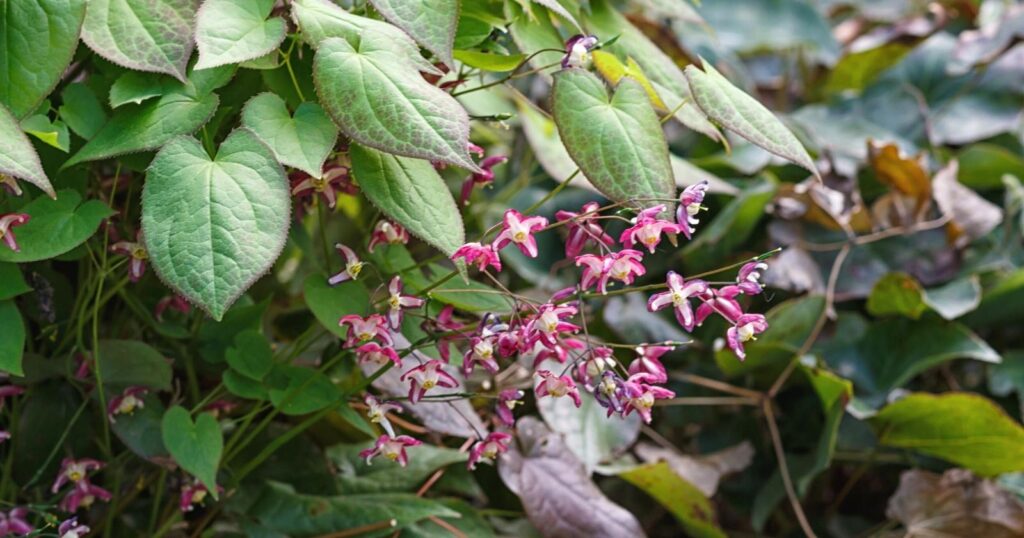
Scientific Name: Epimedium
- Sun Exposure: Partial shade
- Height When Mature: 8-12″ tall
- Soil pH: 5.0 to 7.0
- Plant Zone: 3 to 9
Barrenwort is an odd little plant that produces strangely shaped flowers. It grows between eighteen and twenty-four inches high and has a spread of twenty-four to thirty-six inches. The bizarre little flowers look like three-pointed stars made from hanging bells. They come in many colors, both solid and multicolor, and produce hundreds of flowers at a time.
Barrenwort needs very little care and average watering. It likes well-drained loam, clay, or sandy soils, and will put up with deer, rabbits, dry and rocky soil, and droughts. It rarely acquires pests or diseases and makes for an excellent evergreen groundcover.
Bee Balm
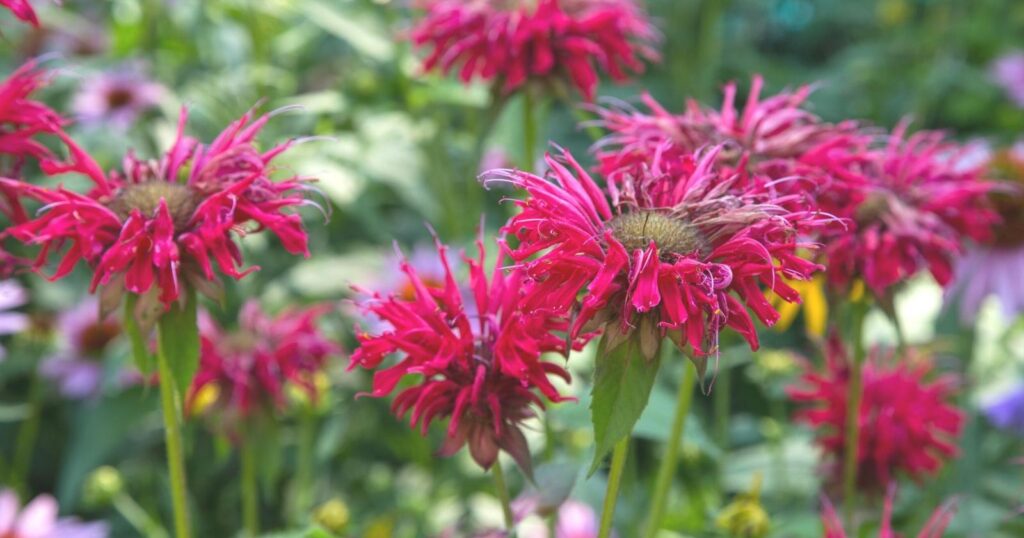
Scientific Name: Monarda
- Sun Exposure: Full sun
- Height When Mature: 2-4″ tall
- Soil pH: 6.0 to 6.7
- Plant Zone: 4 to 9
Bee balm is a vibrant plant that bees adore. This flower will attract honeybees and all kinds of pollinators, butterflies, hummingbirds, and other birds. This perennial thrives in full sun to partial shade, and has average water and care needs.
Bee balm comes in a few different colors, but purple is one of the most popular. It is resistant to deer and rabbits and will tolerate clay soil, though it prefers loam, sandy, or chalk soils.
Bee balm is extremely aromatic and stands at ten to twelve inches high. It has a spread of eight to ten inches and needs moist but well-drained soil.
Bee balm is very showy and accents any garden well. It can grow in containers but needs lots of air circulation to prevent mildew.
Deadhead the flowers after blooming and trim them to the ground when flowering is done. Divide every three years to prevent spread.
Bleeding Hearts
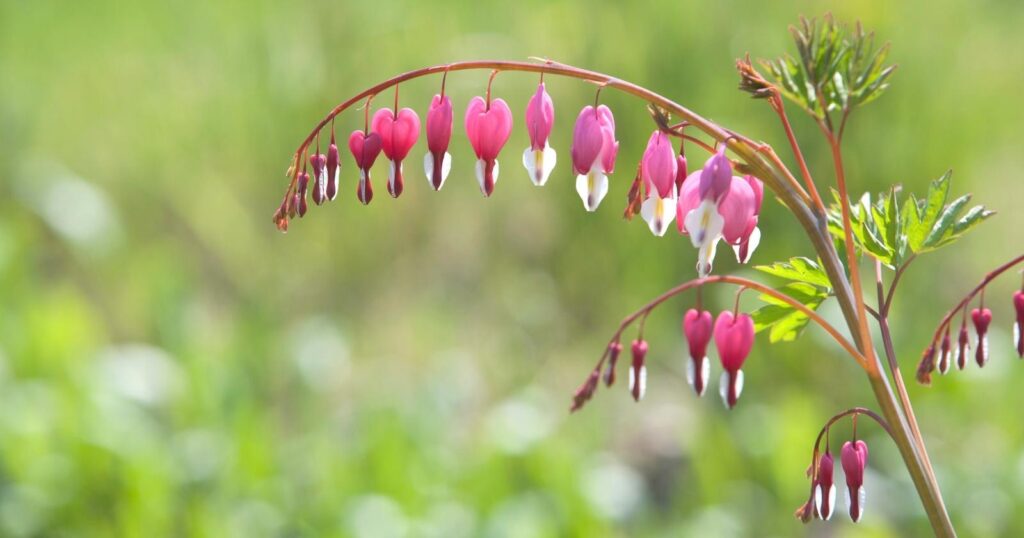
Scientific Name: Dicentra
- Sun Exposure: Partial to full shade
- Height When Mature: 3′ tall
- Soil pH: 6.0 to 6.5
- Plant Zone: 3 to 9
Bleeding hearts are special flowers that form delicate heart shapes. They come in many colors including red, pink, white, purple, and combinations. They like partial sunlight and bloom from spring to fall.
Bleeding hearts reach two to three feet tall and grow best in more northern climates. They are resistant to deer and rabbits and attract hummingbirds and butterflies. These plants rarely have trouble with diseases or pests and are toxic when eaten.
Bleeding hearts look lovely are garden borders and will tolerate heavy shade. They are elegant and stand apart from other flowers quite well. There are also smaller varieties.
Cannas
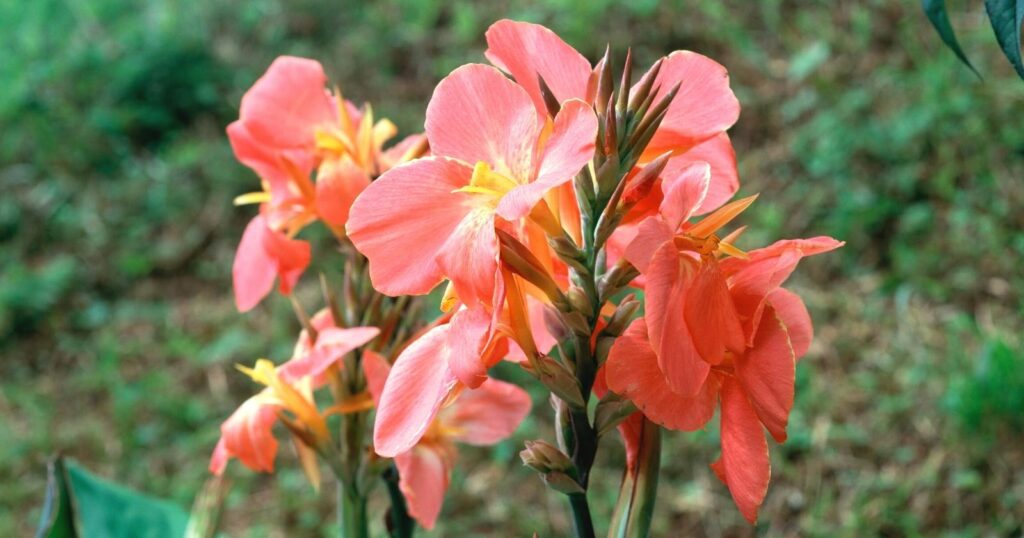
Scientific Name: Canna
- Sun Exposure: Full sun
- Height When Mature: 3-5′ tall
- Soil pH: 6.0 to 6.5
- Plant Zone: 9 to 10
At four to six feet tall, cannas are sun-loving plants that enjoy rich, moist soils with good drainage. They will grow in chalk, loam, sand, and clay soils and don’t mind deer and rabbits.
Cannas do well along walls, hedges, or in garden beds and stand out thanks to their height. They can make flowers of almost any color, and hummingbirds and butterflies love them.
Cannas don’t have much trouble with diseases but may attract pests like the canna leaf roller, Japanese beetles, caterpillars, slugs, and snails. Deadhead flowers for best results.
Cannas are very sensitive to frost, so you may need to excavate the bulbs before the winter frost if you live somewhere colder.
Columbine
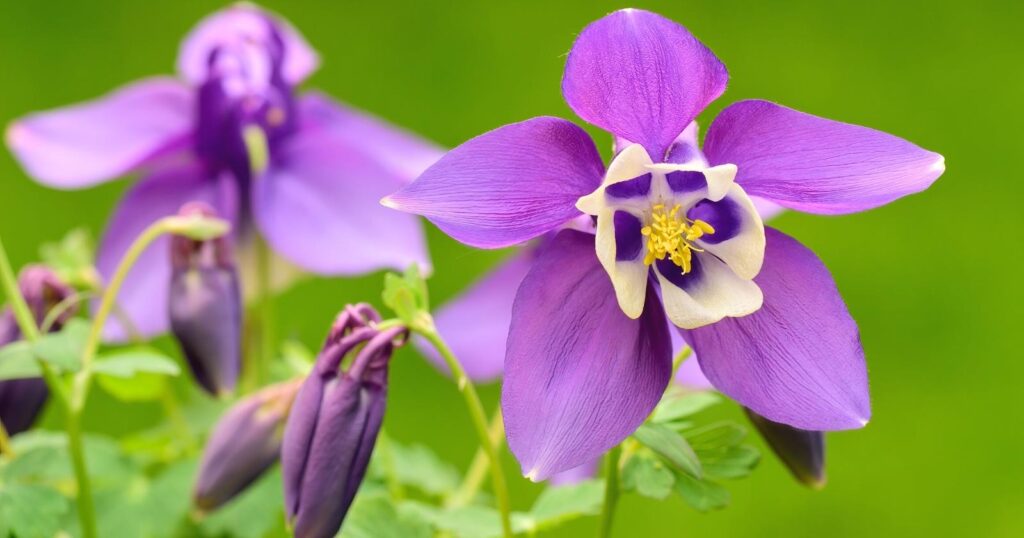
Scientific Name: Aquilegia
- Sun Exposure: Full sun, Partial shade
- Height When Mature: 6-12″ tall
- Soil pH: 6.0 to 8.0
- Plant Zone: 3 to 9
Columbine makes exquisite flowers. Each flower has five petals that stretch back into bell-like little trumpets. This plant grows in moist chalk, loam, clay, or sand soil so long as there is adequate drainage. It is wild and bright in such a way that brings a flurry of color to any garden.
Columbine does well with full and partial sun exposure, average watering, and little maintenance. It grows twenty-four to thirty inches high and eighteen to twenty-four inches wide. For the best results, plant it in rich, moist soil with partial shade, and don’t let the soil get too dry.
Butterflies and hummingbirds love columbine, and it can withstand deer and rabbits. Columbine can have issues with leaf miners but rarely gets diseases. It flowers from late spring until early summer.
Coral Bells
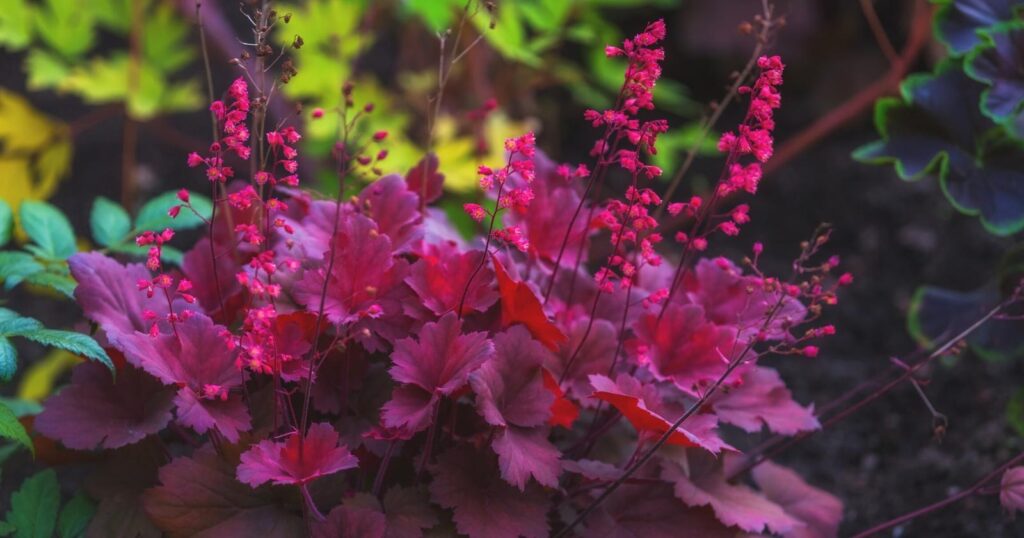
Scientific Name: Heuchera
- Sun Exposure: Partial shade
- Height When Mature: 6-16″ tall,12-36′ wide
- Soil pH: 6.0 to 7.0
- Plant Zone: 4 to 9
Coral bells make pretty little flowers, but the real star of the show is the foliage. Coral bells come in a wide array of colors including red, orange, green, purple, white, and some odd colors like silver, black, and neon green.
The plant can be about eight inches tall and sixteen inches wide, but the flower stalks stick up much higher – up to twenty-six inches. Coral bells need very little care. They can grow with any level of sun or shade and look beautiful year-round.
Coral bells will grow in loam and sand soil types and can tolerate salty soil and deer. Hummingbirds and butterflies flock to them.
They bloom from late spring to early summer, but the leaves also change color throughout the year.
Crocus
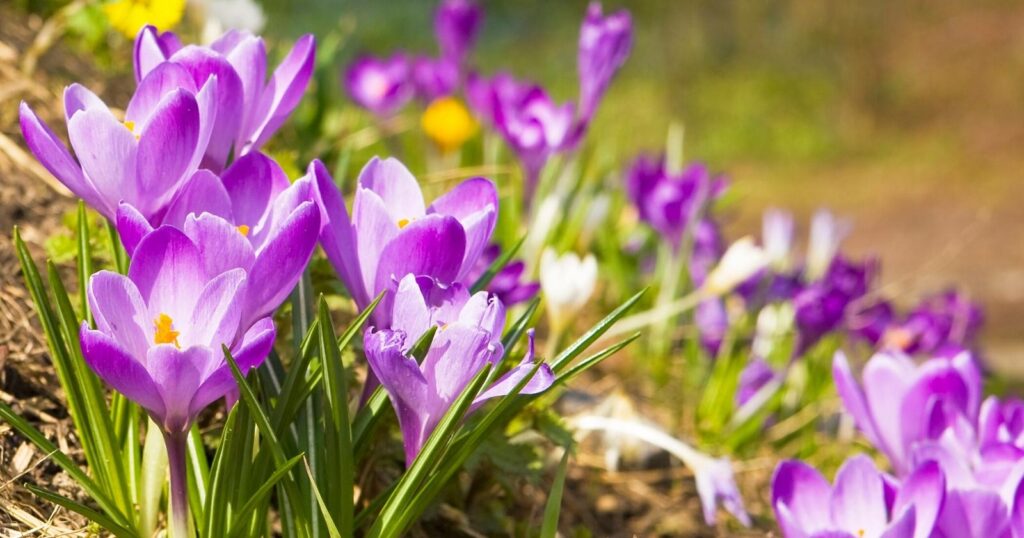
Scientific Name: Crocus
- Sun Exposure: Full sun
- Height When Mature: 2-5″ tall
- Soil pH: 6.0 to 7.0
- Plant Zone: 3 to 8
Crocuses are magnificent little flowers that crop up just about anywhere. They will grow in chalk, loam, sand, and clay-type soils so long as there is proper drainage.
Crocuses come in a variety of colors, but the most common is a shocking violet. These tiny flowers stand at a mere three to four inches in height. They need very little maintenance and average watering.
Crocuses bloom at the end of winter and into early spring. They look best in large groups and need to be planted in the fall.
Crocuses look stunning in gardens or sprinkled in the lawn.
Daffodil
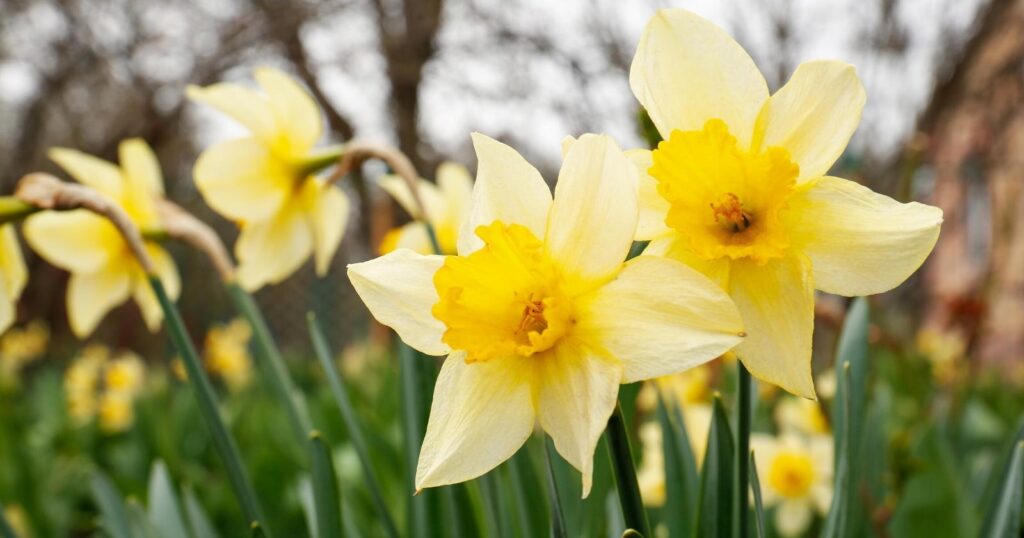
Scientific Name: Narcissus
- Sun Exposure: Full sun, Partial shade
- Height When Mature: 6-30″ tall
- Soil pH: 6.0 to 7.0
- Plant Zone: 8 to 9
Just as their sunny appearance would suggest, daffodils love the sun. They do best in moist but well-drained soil and won’t mind a bit of shade.
Daffodils make yellow, white, and even orange flowers, often combining colors for a wonderful effect. They bloom for only a short period in mid to late spring but often act as the first signal of warm weather. Plant them in the fall for the best results.
Daffodils are resistant to rabbits and deer and don’t require much maintenance. They grow between fourteen and sixteen inches tall and look best when grown in clusters. Do not eat daffodils as they may cause stomach upset and skin irritation.
Daisy
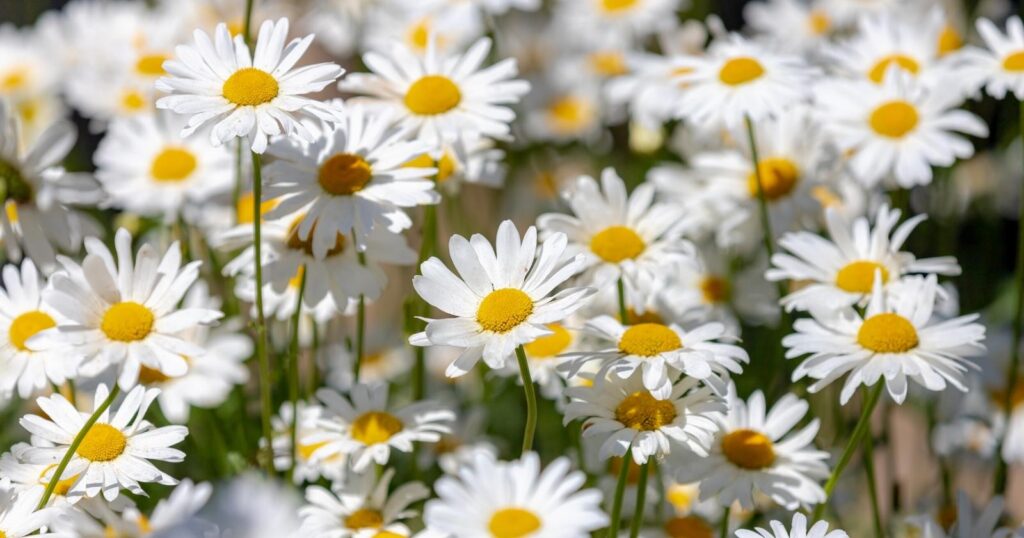
Scientific Name: Bellis perennis
- Sun Exposure: Full sun to Partial shade
- Height When Mature: 8″ tall
- Soil pH: 5.5 to 6.5
- Plant Zone: 3 to 9
Daisies are often disregarded as small, simple-looking plants, but they can be a great addition to any garden looking for a small pop of perennial color.
Daisies come in many shapes and sizes, but usually all bloom from late spring to mid-summer. While some can be quite tall, the common daisy grows to be about four inches high. Daisies don’t need lots of care and will grow almost anywhere in any soil type. As long as they get plenty of sunlight and consistent watering, they’ll keep growing.
Fertilizer will help if your daisies are having a hard time getting established.
Delphinium
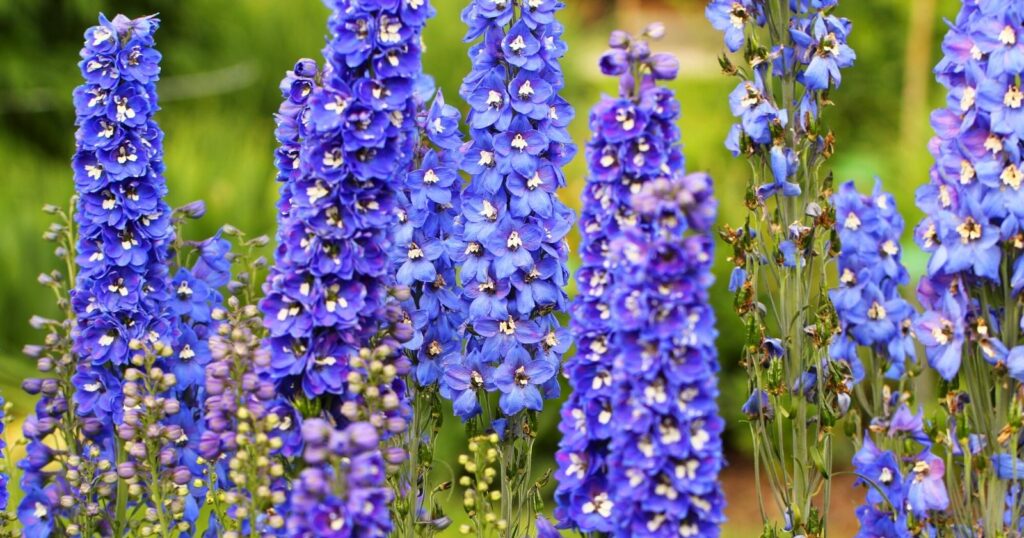
Scientific Name: Delphinium
- Sun Exposure: Partial to Full sun
- Height When Mature: 6′ tall
- Soil pH: 6.5 to 7.0
- Plant Zone: 3 to 7
Delphinium is a very tall plant, standing at five to six feet high and two to three feet side. The flowers grow on the end of long stalks and produce thousands of small ultraviolet flowers.
This plant blossoms in early and mid-summer. It is deer and rabbit resistant and will attract butterflies. Delphinium grows in chalk, sand, and loam soil types and needs the average amount of care and watering.
For the best results, trim down new plants and add fertilizer at the beginning of the blooming season. Watch out for slugs, snails, caterpillars, mildew, leaf miners, and rot. This plant is also toxic when ingested.
Dutchman’s Breeches
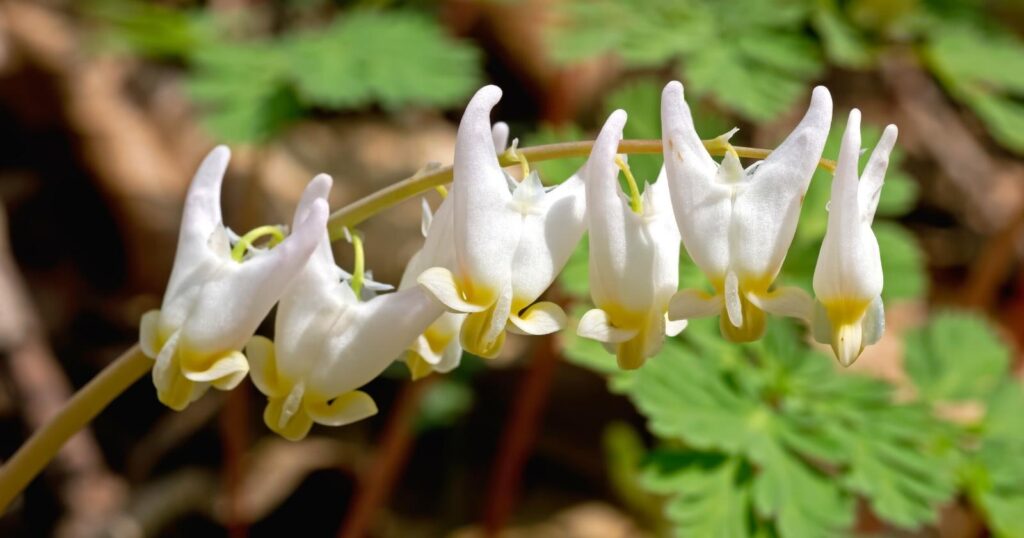
Scientific Name: Dicentra Cucullaria
- Sun Exposure: Partial sun, Partial shade
- Height When Mature: 6-12″ tall
- Soil pH: 6.8 to 7.2
- Plant Zone: 3 to 7
Dutchman’s breeches have a very similar appearance to bleeding hearts, but the flower’s shape resembles a pair of upside-down pants. It will also cause stomach pain if ingested.
Dutchman’s breeches are native to North America and do best with partial sun exposure or heavy shade. They need very little care and average watering with moist but well-drained soil. Chalk, loam, and clay soils are all fine for this plant.
Typically, Dutchman’s breeches grow six to twelve inches tall and can spread considerably farther. It is rabbit resistant, but keep an eye out for snails and slugs. It isn’t likely to have trouble with diseases.
Foxglove
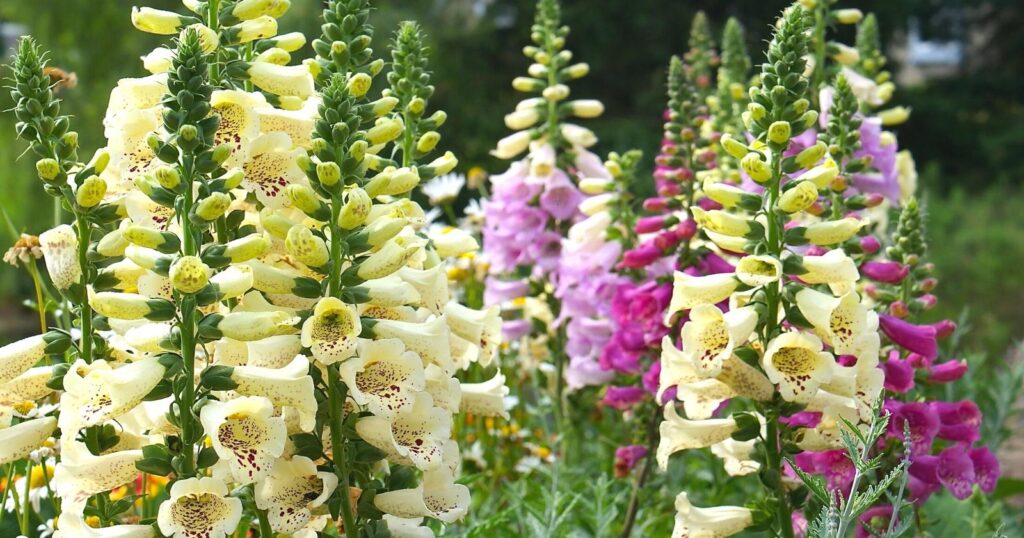
Scientific Name: Digitalis
- Sun Exposure: Full sun to Light shade
- Height When Mature: 2-5′ tall
- Soil pH: 6.5 to 7.0
- Plant Zone: 4 to 9
If you’re looking for a plant with stature to add to your garden, foxglove might be a good option. Foxglove can grow quite tall and usually stands between three and four feet high. It loves the sun but does best with occasional shade.
This plant is resistant to deer, rabbits, and pollution, so feel free to grow it in an urban setting. It also needs very little care and will attract butterflies, bees, and hummingbirds.
While the dappled bell-shaped flowers are quite pretty, foxglove is an invasive species in some areas, so be sure to check before planting.
Foxglove can also have trouble with aphids and leaf spots and may need a little extra help from time to time.
Hibiscus
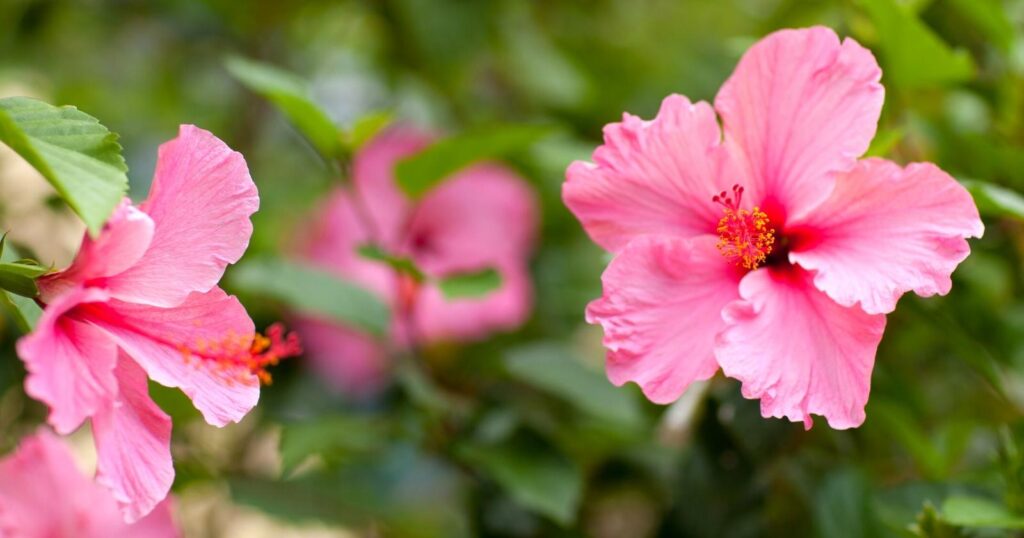
Scientific Name: Hibiscus moscheutos
- Sun Exposure: Full sun
- Height When Mature: 3-7′ tall
- Soil pH: 5.5 to 7.0
- Plant Zone: 5 to 8
Hibiscus is a robust plant that revels in full sun exposure. It is a shrub that stands between three and seven feet high and spans an area of two to four feet.
Hibiscuses attract hummingbirds and butterflies and are resistant to droughts and overly wet soil. They flower through summer and fall, dropping old buds and opening me ones every day.
While the hibiscus plant is generally disease resistant, it can have issues with beetles, canker, rust, leaf spots, and blight.
Hibiscuses can stand periods of drought but generally like wetter soils near streams, rivers, lakes, marshes, and swamps. They will grow in meadows and wetlands with clay and loam soil types and grow well in pots too.
Hollyhock
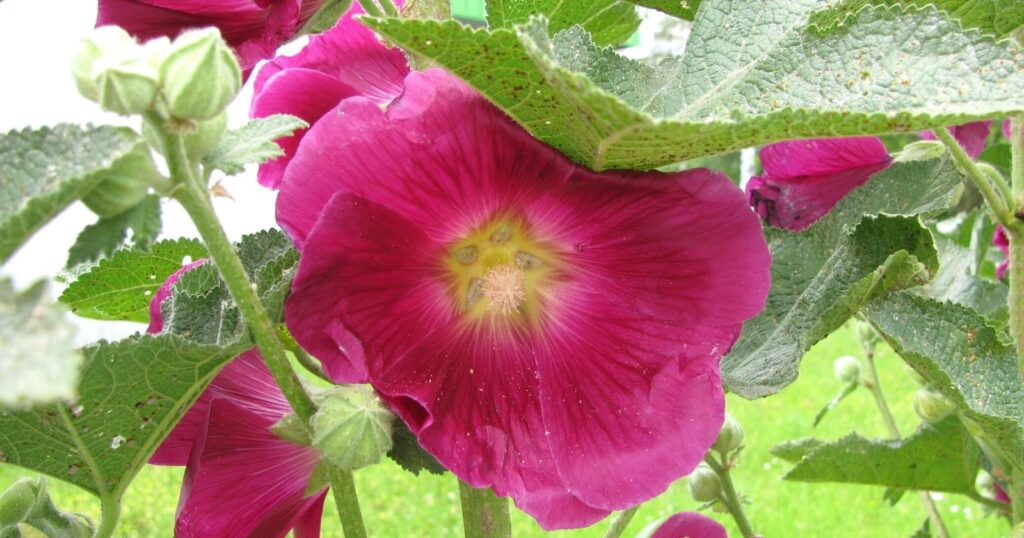
Scientific Name: Alcea
- Sun Exposure: Full sun
- Height When Mature: 5-8′ tall
- Soil pH: 6.5 to 7.2
- Plant Zone: 2 to 10
Perfect for fences, walls, and borders, hollyhock is an old favorite of many gardeners. This plant reaches five to six feet high and spreads over a two-foot area. The long shoots reach up and support hundreds of medium-sized flowers that bloom from the base up.
The hollyhock flower is short-lived, and they only bloom in early and mid-summer. Hummingbirds and butterflies love hollyhock, and it is resistant to rabbits.
Hollyhock is best planted in full sun and well-drained but moist soil. It is easy to grow but needs frequent care. Cut back after flowering for best results.
Honeysuckle
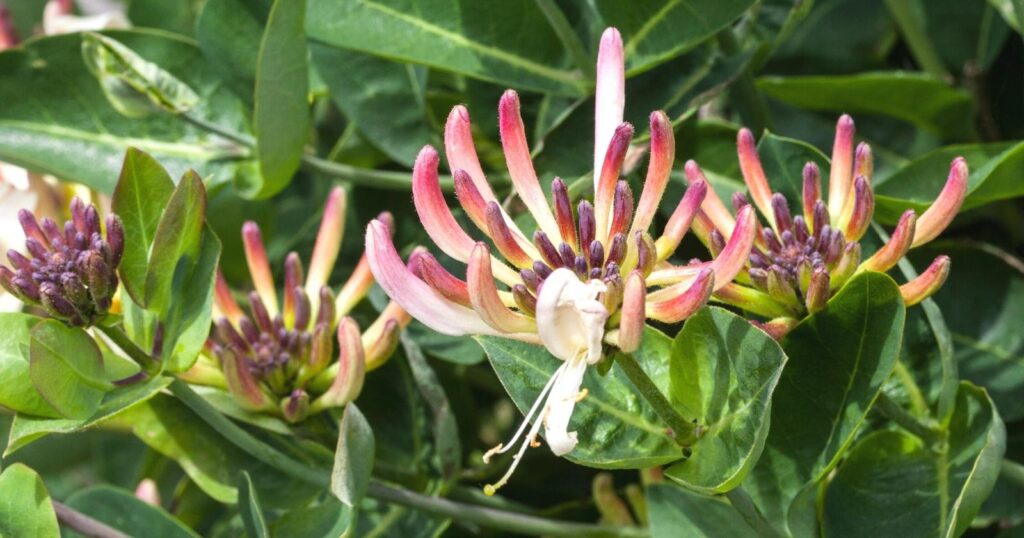
Scientific Name: Lonicera
- Sun Exposure: Full sun
- Height When Mature: 15-20′ tall
- Soil pH: 5.5 to 8.0
- Plant Zone: 5 to 9
Honeysuckle is a fragrant shrub renowned for its winter blooms. It is sweet-smelling and will start to flower at the end of winter into early spring. The plant grows six to ten feet tall and just as wide. It likes full and partial sun exposure and chalk, loam, clay, and sand soils.
Honeysuckle doesn’t need much water or care and can withstand droughts, dry soil, clay soil, and deer. It doesn’t need pruning, but shaping should be done following flowering if you choose to. Some varieties of honeysuckle are invasive, so be sure to check which are okay in your area.
Hosta
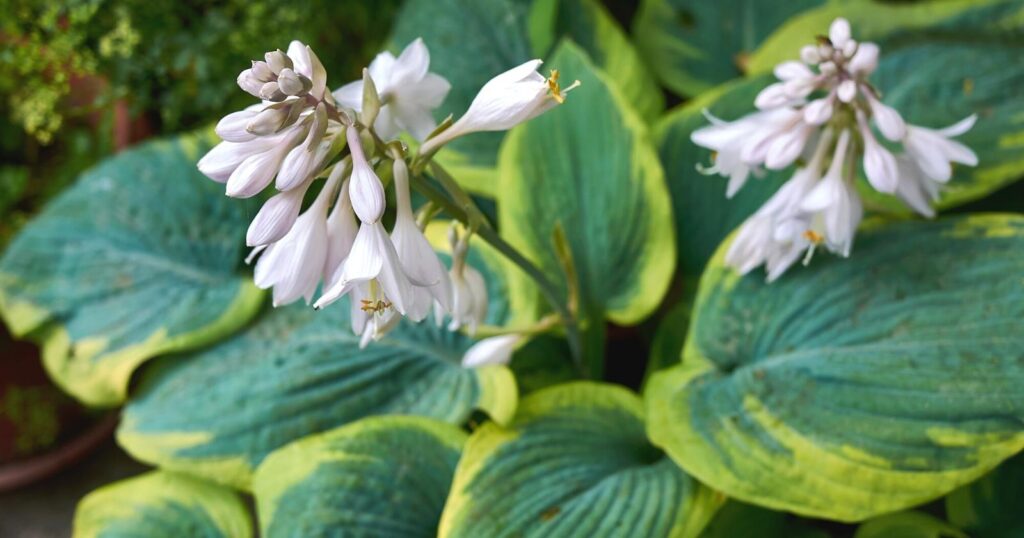
Scientific Name: Hosta
- Sun Exposure: Partial shade
- Height When Mature: 4′ tall, 6′ wide
- Soil pH: 6.5 to 7.5
- Plant Zone: 3 to 9
Hostas are easy plants to grow. They only need a bit of sunlight and an average water supply. These leafy plants are super low effort and will grow in clay or loam soils with sufficient drainage.
Hostas grow about twenty inches tall and forty-two inches wide. They like moist and rich soil. For the best results, keep snails and slugs off and trim back discolored leaves to maintain the overall appearance.
Hummingbirds like the flowers that bloom in the summer. Hostas grow quickly, so you may need to work to keep them in their space.
Hyacinth
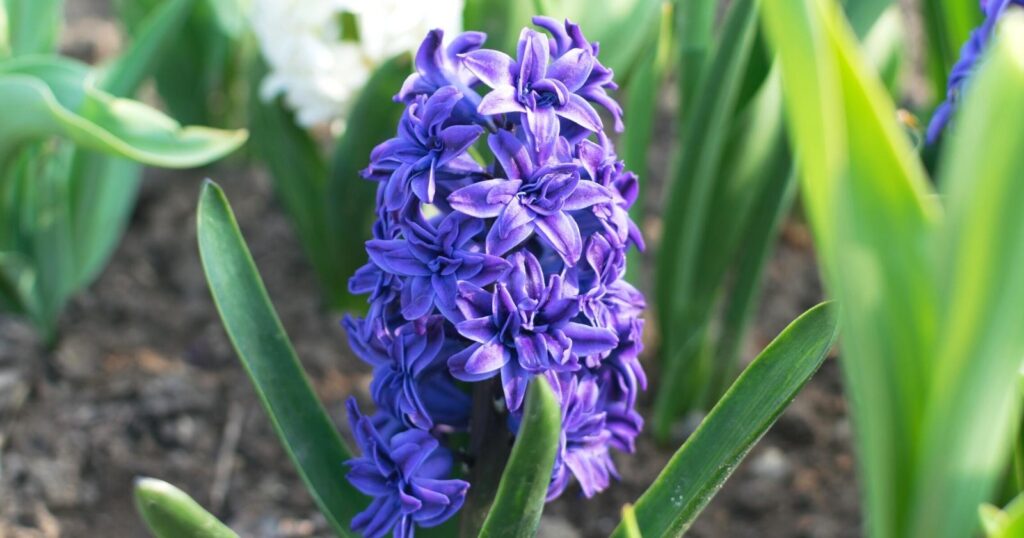
Scientific Name: Hyacinthus
- Sun Exposure: Full sun to Partial shade
- Height When Mature: 6-10″ tall
- Soil pH: 5.8 to 6.0
- Plant Zone: 3 to 9
Hyacinths are six to ten inches tall and three to four inches wide. They make tapered clusters of flowers that bloom brilliantly in mid-spring. They can easily withstand deer and rabbits.
Hyacinths come in many colors, but the most striking is blue. They grow in loam, sand, chalk, and clay-type soils in moist, well-drained conditions. They have average water needs and don’t need much care.
These flowers do well with a bit of shade but can do just as well in the sun. They are best planted in the fall. Hyacinths can cause stomach pain if ingested and may be a skin irritant.
These flowers look stunning in arrangements and perfect in flower gardens.
Hydrangea
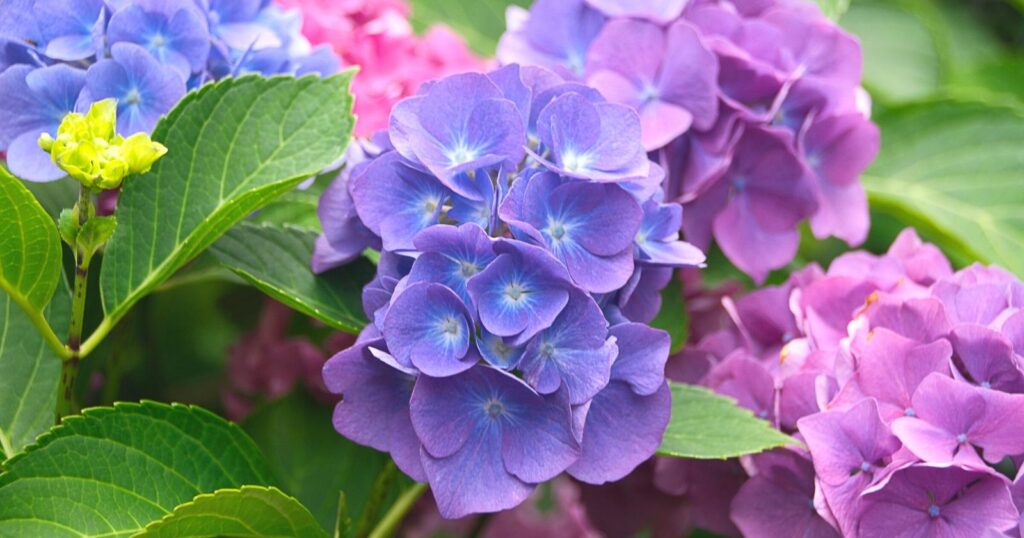
Scientific Name: Hydrangea
- Sun Exposure: Partial sun
- Height When Mature: 2-3′ tall
- Soil pH: 6.0 to 6.2
- Plant Zone: 3 to 7
Hydrangeas are large, shrub-like plants that reach heights of three to five feet and get just as wide. They make large clusters of many thousands of tiny flowers and come in an abundance of colors. Hydrangeas have a wide range of styles, and there are even some climbing varieties.
This plant loves lots of sunlight and some shade and will grow in loam, clay, and sand soil types so long as they are well-drained and moist.
Hydrangeas make for wonderful cut or dried flowers and need deadheading at the end of each flowering season. They may be prone to mold, mildew, leaf spots, scale, mites, rust, bud blight, bacteria wilt, aphids, and nematodes.
Iris
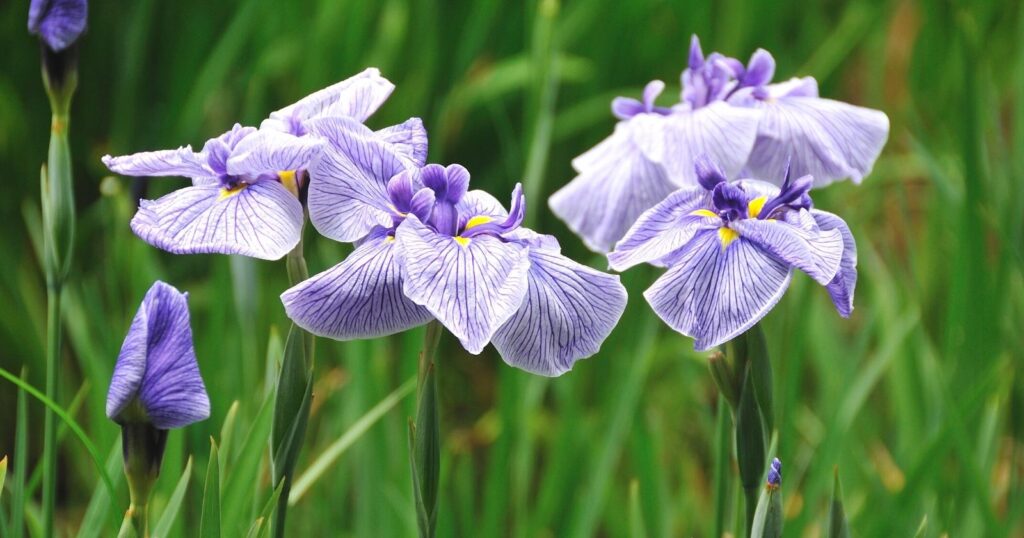
Scientific Name: Iris
- Sun Exposure: Full sun
- Height When Mature: 6-12″ tall
- Soil pH: 6.5 to 6.8
- Plant Zone: 3 to 9
Irises come in a great many colors and variations. Some of the most common include the bearded iris and the dwarf iris, but there are more mystical-looking ones as well.
The bearded iris is a common staple in many gardens and stands at three to four feet in height and one to two feet wide. It produces many large flowers throughout the end of spring and the beginning of summer.
Irises like loam and sand soils, average watering, and average care. They can withstand deer, rabbits, and drought. Irises are a gorgeous addition to any garden and pair well with other showy flowers. Do not eat them.
Lavender
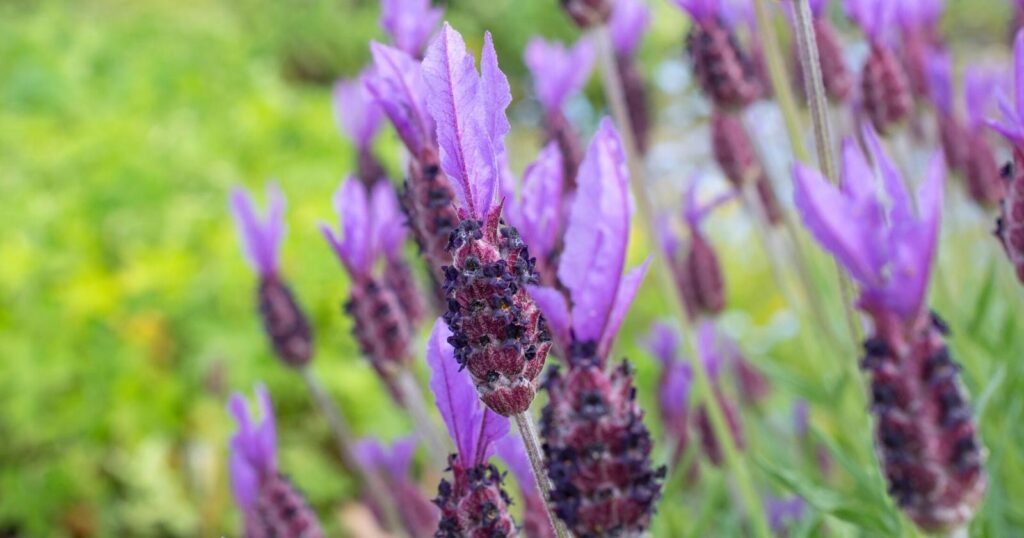
Scientific Name: Lavandula
- Sun Exposure: Full sun
- Height When Mature: 12-18″ tall
- Soil pH: 6.5 to 7.5
- Plant Zone: 5 to 9
The fragrant lavender flower is a staple of many gardens. While purple is the most well-known variant, lavender also comes in pale pink and white.
Lavender stands at twenty to twenty-four inches high and spreads in groups twenty-four to thirty inches wide. It blooms from late spring through mid-summer and enjoys unencumbered sunlight. Lavender grows best in moist but well-drained soil and doesn’t mind rocky ground, dry turf, or drought.
Lavender is a favorite of bees and other pollinators and will attract plenty of butterflies. It is also resistant to rabbits and deer.
For the best results, cut back the lavender in spring.
Lily
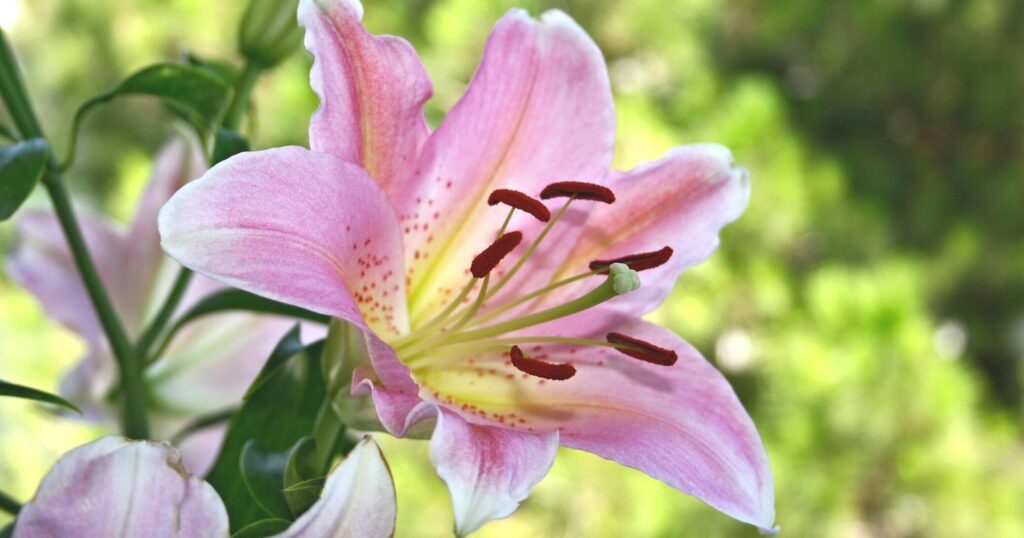
Scientific Name: Lilium
- Sun Exposure: Full sun, Partial shade
- Height When Mature: 4-6′ tall
- Soil pH: 6.5 to 7.0
- Plant Zone: 4 to 9
Lilies are some of the most well-known flowers for their beauty and vitality. They come in a range of colors and varieties. The lily is a resilient plant with good resistance to rabbits, deer, and disease.
Lilies love sunlight and are attractive to butterflies. They grow in chalk, sand, clay, and loam-type soils. They like regular water but need proper drainage.
Lilies are beautiful in the garden or in arrangements as they grow three to four feet tall and make six to eight flowers per stem. They also require very little maintenance.
Lilies will bloom from mid to late summer and are very fragrant. While they are a favorite of bees, they are toxic to cats.
Lily of the Valley
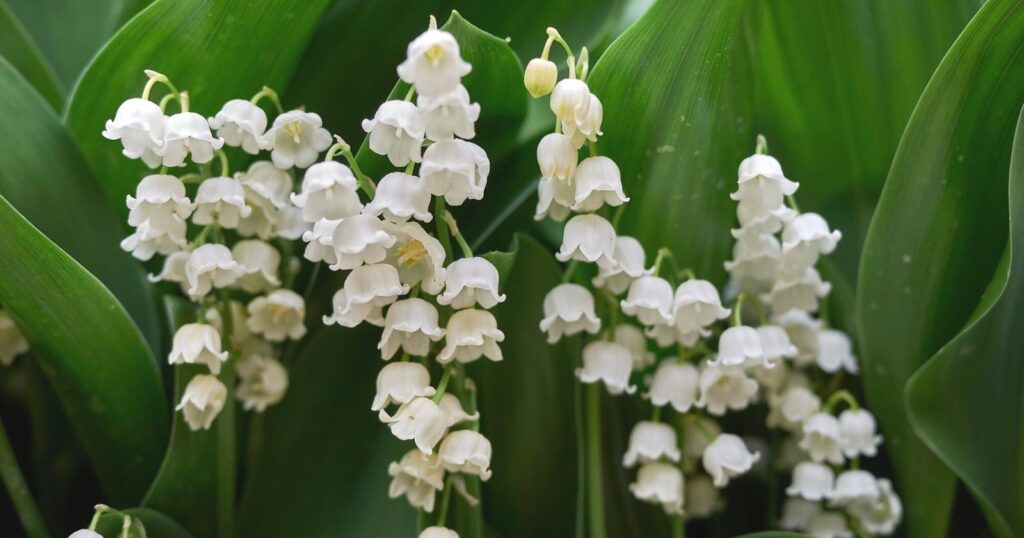
Scientific Name: Convallaria majalis
- Sun Exposure: Partial to Full shade
- Height When Mature: 8-12″ tall
- Soil pH: 6.0 to 6.5
- Plant Zone: 3 to 8
Lily of the valley is a unique perennial with a delicate and entrancing nature. It stands a mere six to twelve inches off the ground, yet commands attention with its tiny bell-like flowers.
Lily of the valley smells sweet and exists with little outside care. It will grow in clay and loam-type soils and loves a yearly sprinkle of organic compost. This plant likes wetter soil but will tolerate dry ground and can withstand deer and rabbits. It blooms in early to mid-spring but may start later in colder climates.
The bright green leaves and pure white petals are stunning to look at but are toxic and may be invasive in some areas of North America.
Lungwort
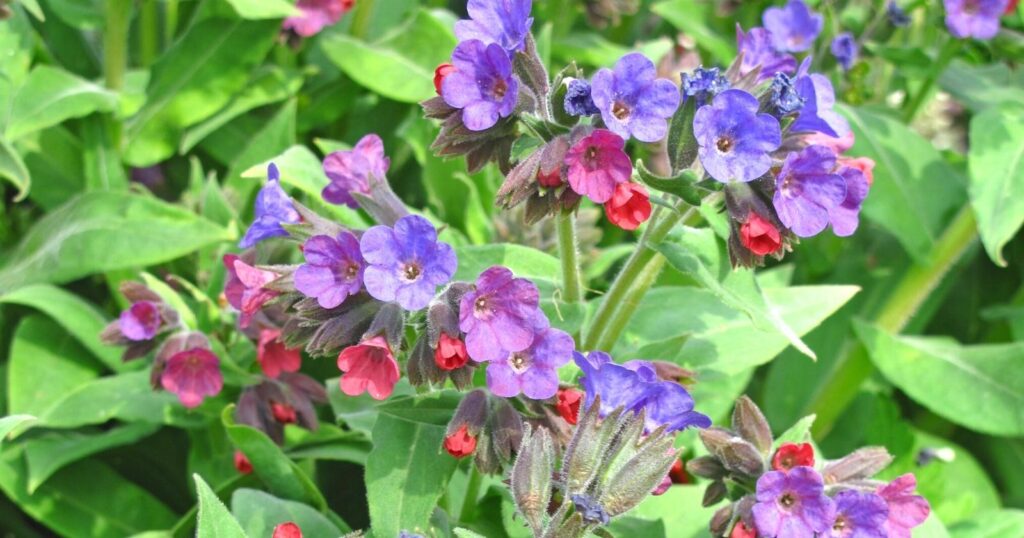
Scientific Name: Pulmonaria
- Sun Exposure: Partial sun to Full shade
- Height When Mature: 6-12″ tall
- Soil pH: 7.0 to 7.5
- Plant Zone: 3 to 9
Despite the ugly name, lungwort is a very pretty flower. It mostly comes in blue, purple, pink, and red varieties but can have several different colored flowers on one plant.
Lungwort grows ten to twelve inches high and spreads over a twelve to eighteen-inch area. It can grow on banks and slopes and doesn’t mind deer and rabbits. Lungwort grows in chalk, loam, and clay soils and needs an average amount of water through moist but well-drained soil. It requires little outside care.
Lungwort blooms brightest when you remove the flower stems immediately after flowering and give it lots of shade.
Monkshood
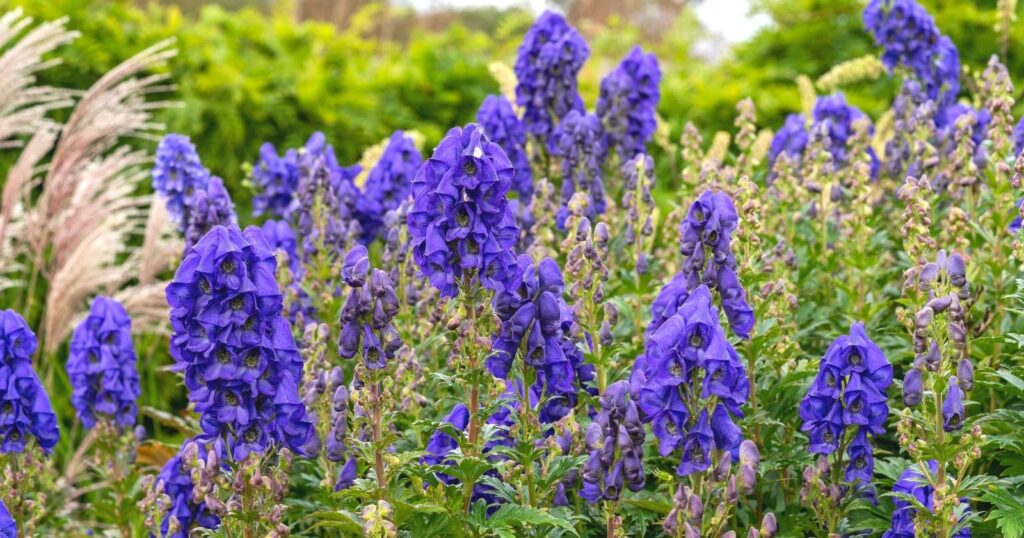
Scientific Name: Aconitum
- Sun Exposure: Full sun to Partial shade
- Height When Mature: 2-4′ tall
- Soil pH: 5.5 to 6.5
- Plant Zone: 3 to 7
Monkshood is a similar-looking plant to foxglove. It produces tall stems adorned with bell-shaped flowers that bloom in the fall. It enjoys lots of sunlight and partial shade and will grow in moist clay or loam soils with good drainage. Monkshood doesn’t need special care or excessive watering.
This plant grows two to four feet high and twelve to eighteen inches wide. It is deer and rabbit resistant and looks lovely in beds and borders.
All parts of this plant are highly toxic so avoid planting it where children or pets might get to it and use gloves when handling it.
Mums
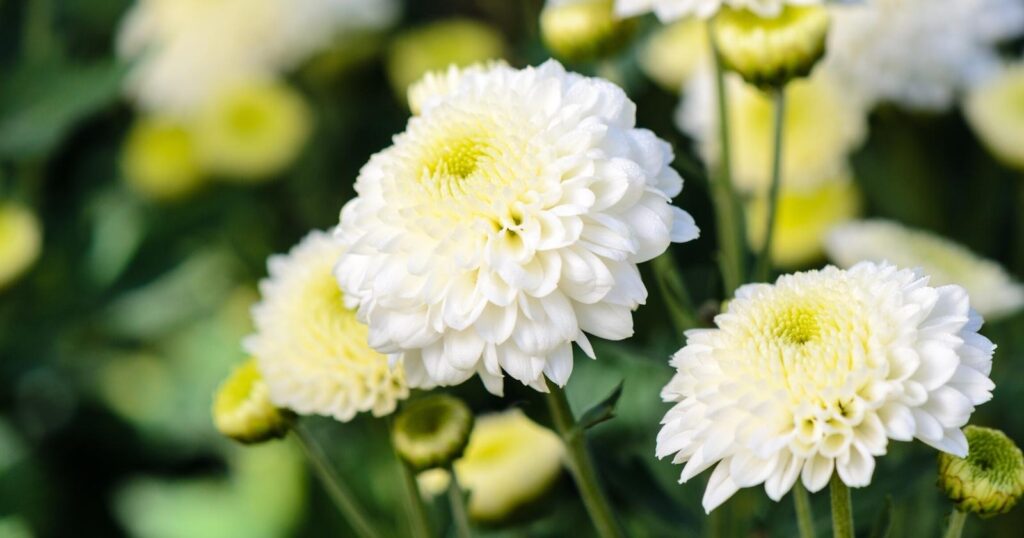
Scientific Name: Chrysanthemum morifolium
- Sun Exposure: Full sun
- Height When Mature: 2-3′
- Soil pH: 6.0 to 6.5
- Plant Zone: 5 to 9
Mums are excellent flowers to add volume and density to a garden. They love full sun exposure and have average water and maintenance needs. They grow in clay, loam, and sand-type soils and are easy to care for.
Mums reach six to sixteen inches in height and ten to eighteen inches in width. They need sheltered locations that get plentiful sunlight and have good drainage. Mums typically flower in the fall. They need shaping as they grow to achieve the standard bushy shape.
Mums come in many sizes and colors. Try planting a variety in one area for some spectacle.
Myrtle
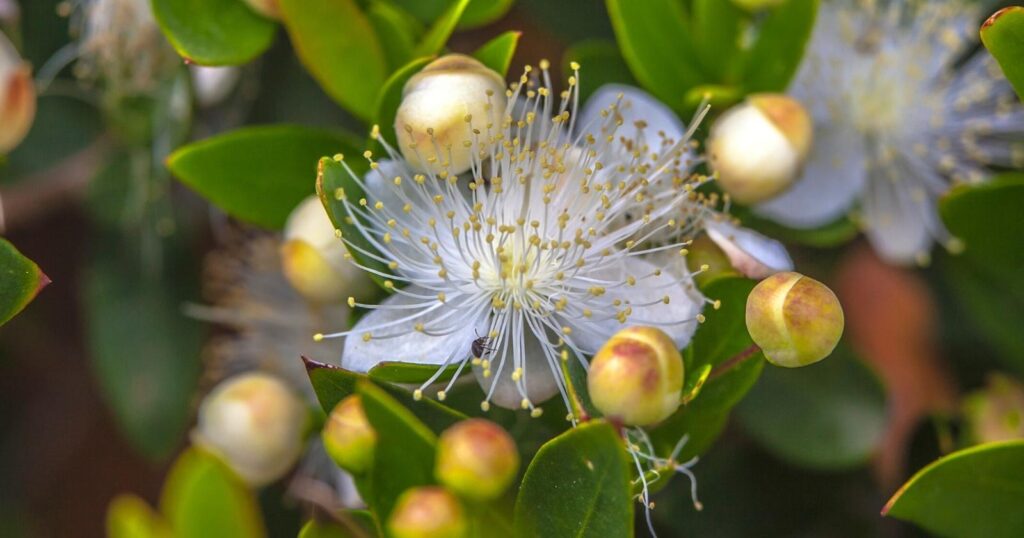
Scientific Name: Myrtus
- Sun Exposure: Full to Partial sun
- Height When Mature: 5-6′ tall
- Soil pH: 6.1 to 8.3
- Plant Zone: 8 to 10
Myrtle is a cute little plant that produces fuzzy-looking flowers and blue berries. It is, in fact, not a little plant as it can grow eight to twelve feet tall and wide. Myrtle is a shrub with delicate spade-shaped leaves and unique white flowers. It is virtually disease and pest-free and looks lovely almost anywhere.
Myrtle grows in moist, well-drained chalk, loam, clay, and sand soils. It is resistant to deer and droughts and can even grow in containers.
This plant loves direct sun exposure and has very low care and water needs. It blooms from mid-spring to early summer before sprouting blue berries in the wake of the flowers. This plant is fabulous for new gardeners as it stays nice looking and neat without any help.
Peony
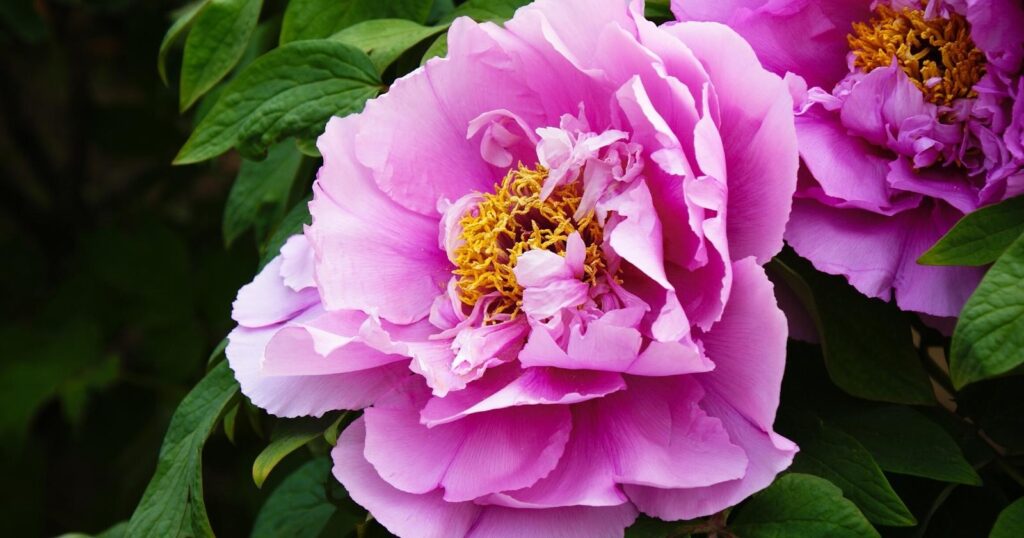
Scientific Name: Paeonia
- Sun Exposure: Full sun
- Height When Mature: 3-5′ tall
- Soil pH: 6.5 to 7.0
- Plant Zone: 3 to 8
Peonies are very hardy plants. They can withstand high heat and lots of sunlight and aren’t easily affected by the cold. They bloom in late spring through early summer and rarely face diseases or pests. Honey fungus and peony wilt are some of the only diseases peonies have to combat.
While peonies require little care, they do need regular watering. Peonies aren’t drought resistant. They need well-drained but moist soil.
Peonies will attract butterflies, and while they only bloom for a few weeks, they make for excellent cut flowers. They also grow well indoors and in pots.
For the best results, plant your peonies in a sheltered location with partial shade. Larger peonies may require staking, and all peonies can benefit from fertilizer.
Peonies are also resistant to deer and rabbits and grow about thirty inches tall, twenty-four to thirty-six inches across and have two to three-inch-wide flowers.
Phlox
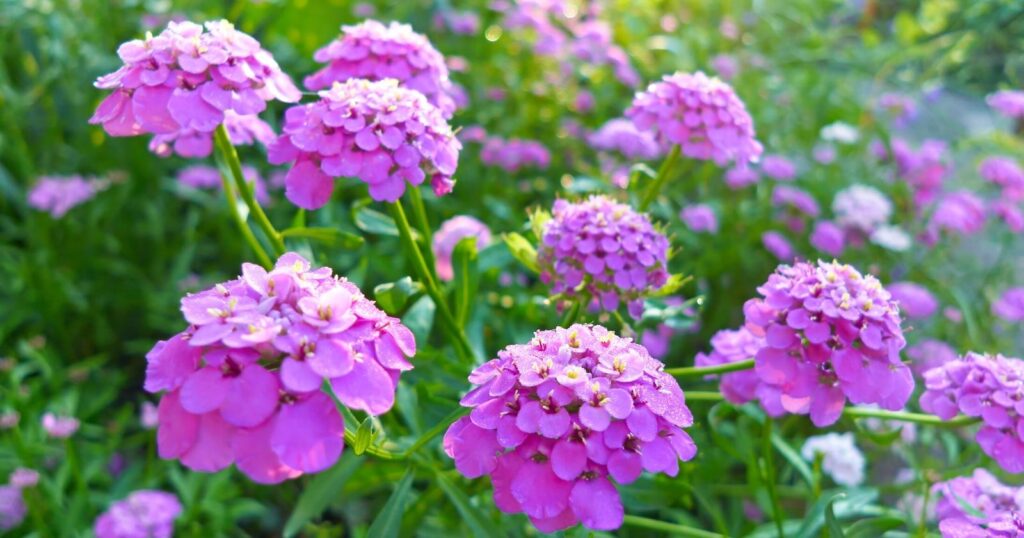
Scientific Name: Phlox
- Sun Exposure: Full sun
- Height When Mature: 2-3′ tall
- Soil pH: 6.0 to 8.0
- Plant Zone: 4 to 8
Phlox grows in dense clusters and produces bright bushels of multicolored flowers. It comes in many colors, but purple, pink, white, and red are the most common.
Phlox is a summer flower that does best with lots of sunlight and partial shade. It grows in chalk, loam, and clay soil types and is resistant to deer. It can grow three to four feet tall and has a wide spread.
Phlox attracts hummingbirds and butterflies but can acquire mold and mildew.
Phlox is self-seeding and looks good in large groups and small clusters. It also has a sweet fragrance.
Rose
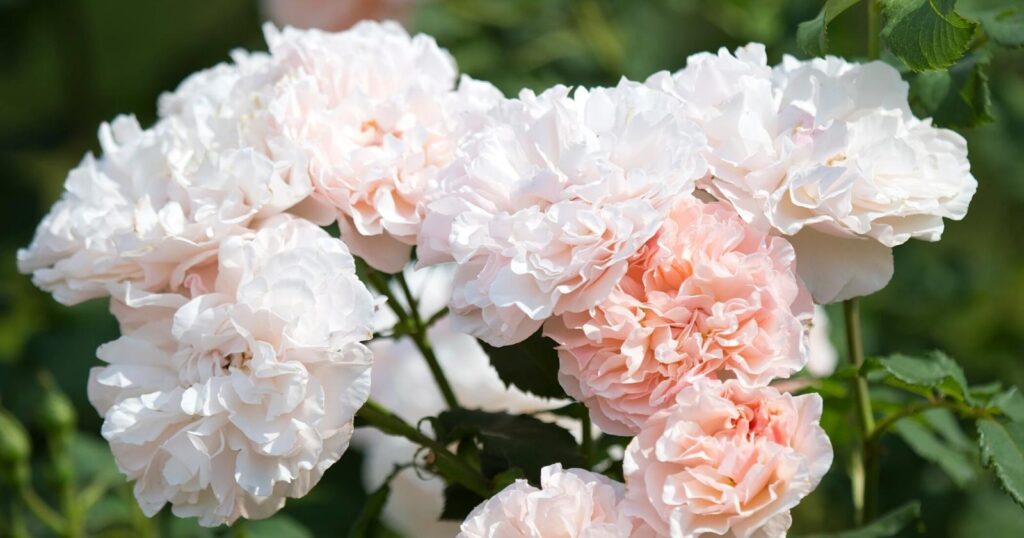
Scientific Name: Rosa
- Sun Exposure: Full sun
- Height When Mature: 8″ to 50′ tall
- Soil pH: 6.0 to 6.5
- Plant Zone: 1 to 9
Roses are versatile and exquisitely beautiful. There are a nearly endless variety of roses, so there is bound to be one that fits your garden and climate.
Roses grow between six to eight feet tall, with some reaching as high as twenty feet. The flowers are large at six or seven inches wide.
Roses bloom from late spring to early summer and like lots of sunlight. They are shade tolerant and like sand, clay, and loam soils. Add compost or fertilizer for the best result.
Roses have a bold, signature scent that makes them stand out. They look lovely as cut flowers and can be propagated through cuttings.
Salvia
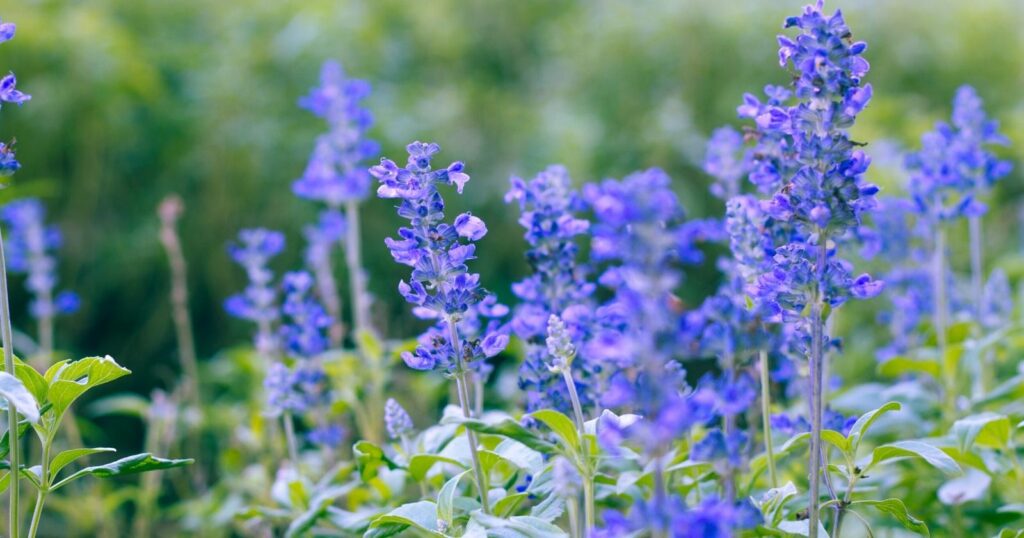
Scientific Name: Salvia
- Sun Exposure: Full sun
- Height When Mature: 12-24″ tall
- Soil pH: 5.5 to 6.5
- Plant Zone: 4 to 10
Sage comes in many colors that will saturate your garden with life. It is a robust plant that grows in direct sunlight in almost any type of soil.
Salvia blooms from April through December and brings in butterflies and hummingbirds. It will grow well in containers and can tolerate drought.
Salvia reseeds easily but may require cutting back in the spring to prevent excessive spread. Start by planting from a transplant between September and October for the best results. Additionally, let the plant dry out a bit between watering, as overwatering can cause the plant to wilt, mold, or wither.
Sedum
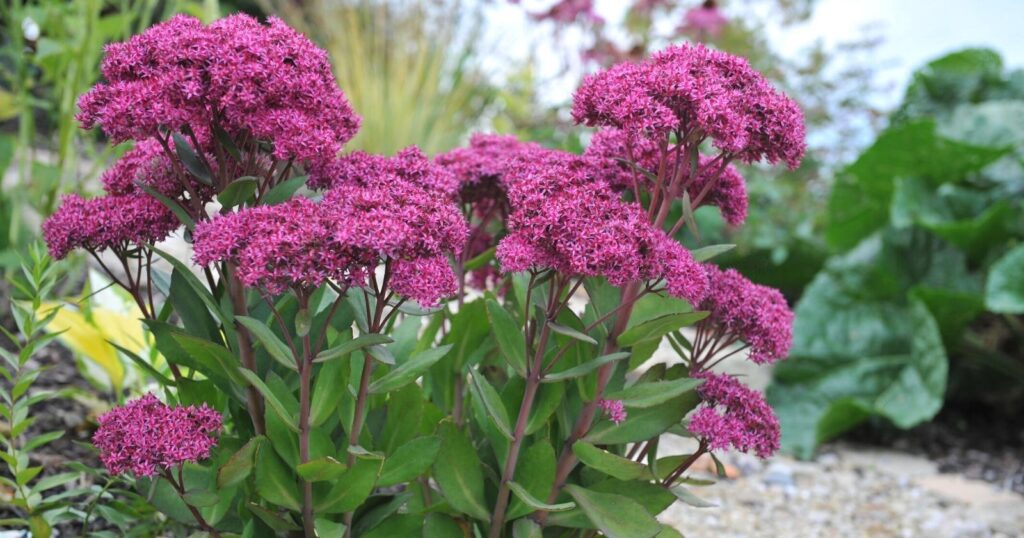
Scientific Name: Sedum
- Sun Exposure: Full sun, Partial sun
- Height When Mature: 1-3′ tall
- Soil pH: 6.1 to 6.5
- Plant Zone: 3 to 11
Sedum is a unique plant that blooms from late summer and through fall but remains attractive throughout winter. The flowers grow in clusters of tiny petals that change color depending on the season and their state of growth.
Sedum stands at twenty-four to thirty inches high and spreads out eighteen to twenty-four inches wide. It attracts birds and butterflies and can withstand deer, rabbits, and drought. This plant loves direct sunlight and barely requires any watering or maintenance. It can even withstand complete neglect.
Sedum is great for those who want a low-maintenance garden as it rarely has trouble with pests or diseases either. Sedum grows in chalk, loam, and sand soil types and will grow even in poor soil conditions.
Trillium
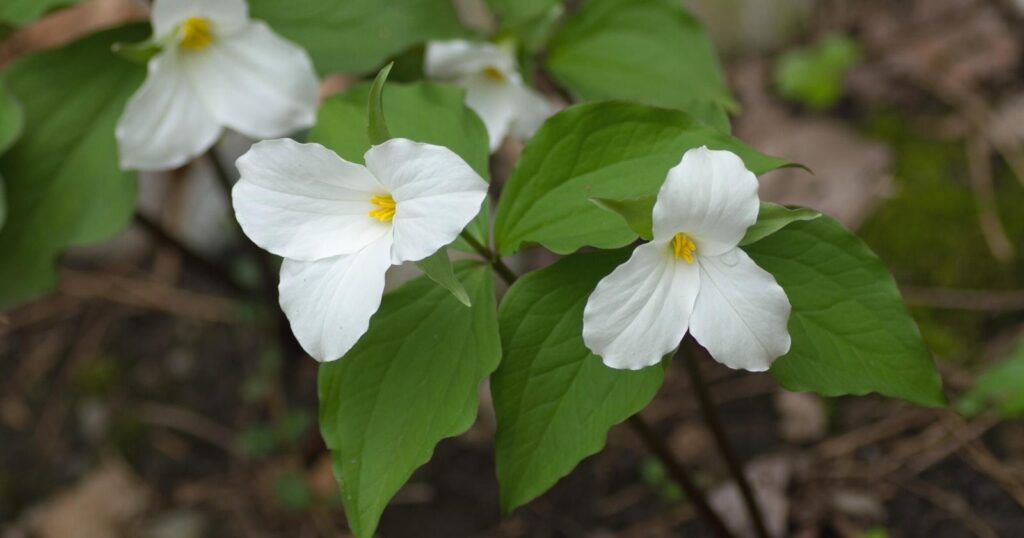
Scientific Name: Trillium
- Sun Exposure: Full shade, Partial shade
- Height When Mature: 6″ tall, 4″ wide
- Soil pH: 6.8 to 7
- Plant Zone: 4 to 9
Trilliums are native to North America and are the provincial flower of Ontario. They mainly come in white and red varieties and are known for their unique three-leaf-three-petal formation.
Trilliums are twelve to eighteen inches high and twelve inches wide. They grow in loam, chalk, and sand soils and like to keep mostly in the shade. They need average watering with good drainage but require little to no outside help beyond that. Trilliums are nearly disease-free and bloom from mid-spring to early summer.
This plant is best for shady gardens and should be planted in fall or early spring.
Tulips
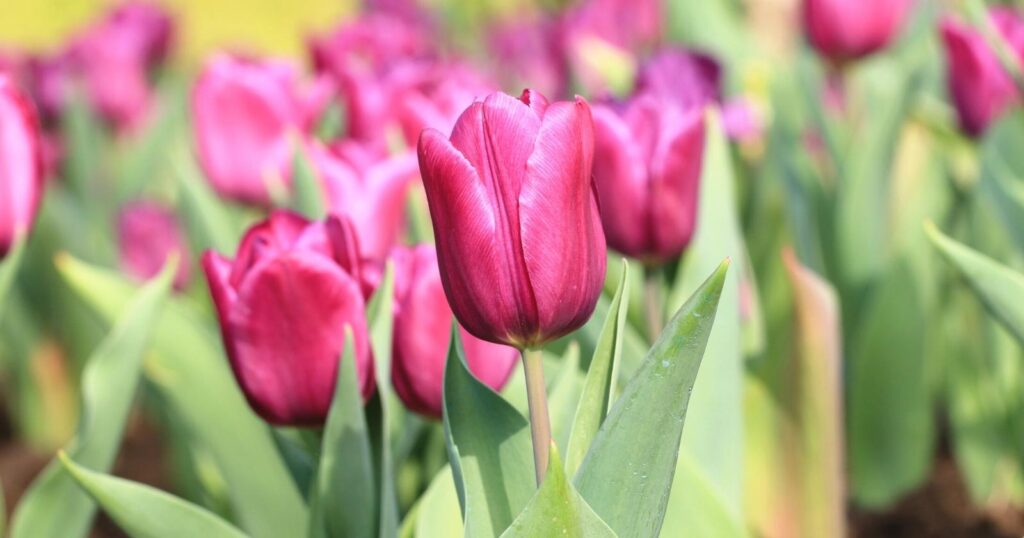
Scientific Name: Tulipa
- Sun Exposure: Full sun, Partial shade
- Height When Mature: 6-9″ tall
- Soil pH: 6.0 to 6.5
- Plant Zone: 3 to 8
The unique profile of the tulip makes it stand out in any garden. This sunlight-loving flower blooms in the latter half of spring and brings a pop of color with it. Tulips come in a ridiculous number of colors and even multicolor varieties.
The long single stem of the tulip makes it the perfect flower for cut arrangements and a unique centerpiece of the garden. Tulips are generally ten inches tall.
Chalk, loam, and sand soil is all fine for tulips as long as they get regular watering. They can withstand dry summers but don’t do well in extreme heat. They grow outside, inside, and in pots well.
Plant the bulbs in the fall and do not eat tulips as they can cause stomach upset and allergic reactions.
Yarrow
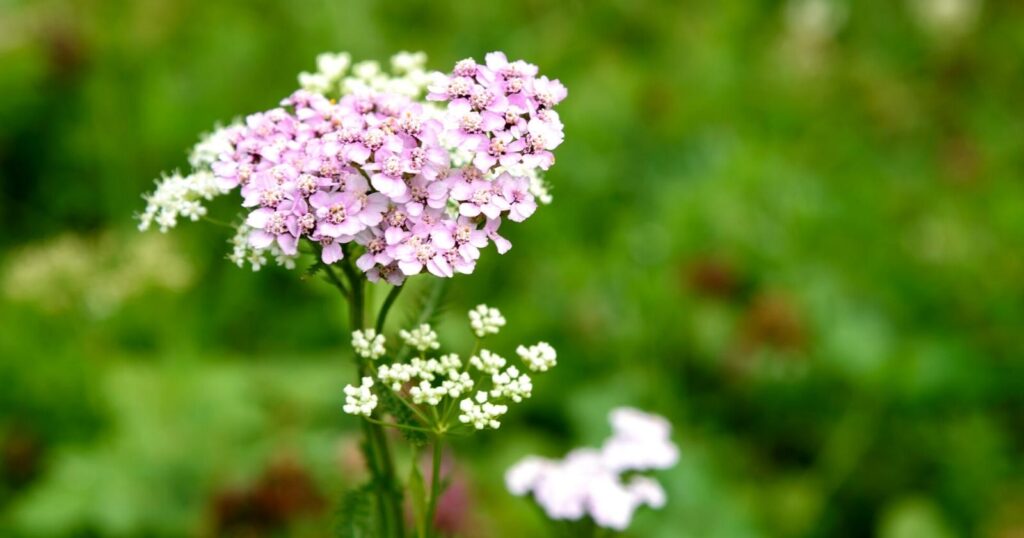
Scientific Name: Achillea millefolium
- Sun Exposure: Full sun
- Height When Mature: 3′ tall
- Soil pH: 5.5 to 6.8
- Plant Zone: 4 to 8
Yarrow is a steadfast and hardy plant that can take high heat and full sun. It is easy to care for and produces beautiful, herbaceous flowers. The flowers form in wide clusters that stay bright and bloom from June to September. The flowers come in red, yellow, pink, and white varieties.
Once established, Yarrow is drought-tolerant and nearly indestructible, making it a perfect plant for first-time gardeners. It doesn’t need much water. Deadheading helps to extend the blooming season.
Butterflies love yarrow, and it looks great in any garden. Yarrow grows to about thirty inches tall and spreads over two feet. It looks lovely in arrangements or meadow-style gardens.
Final Thoughts
These zone 5 perennials can all be great additions to your garden or landscaping area. They look exquisite, most are easy to care for, and they can all survive the conditions of a zone 5 garden. Whether you want to add some small flowers, a medium bush, flowers with long shoots, or a massive shrub, there are bound to be perfect perennials here for you.

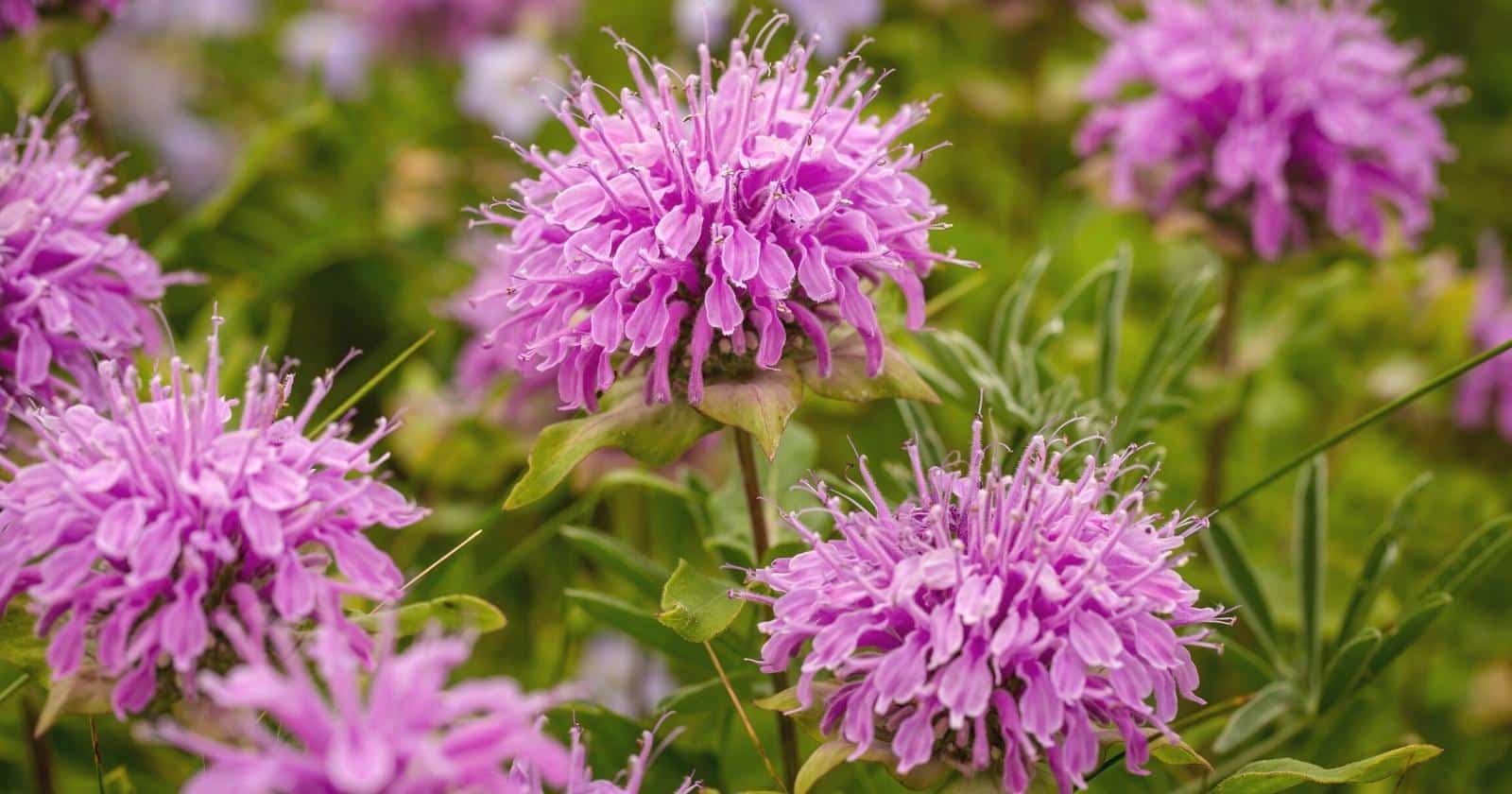
Leave a comment